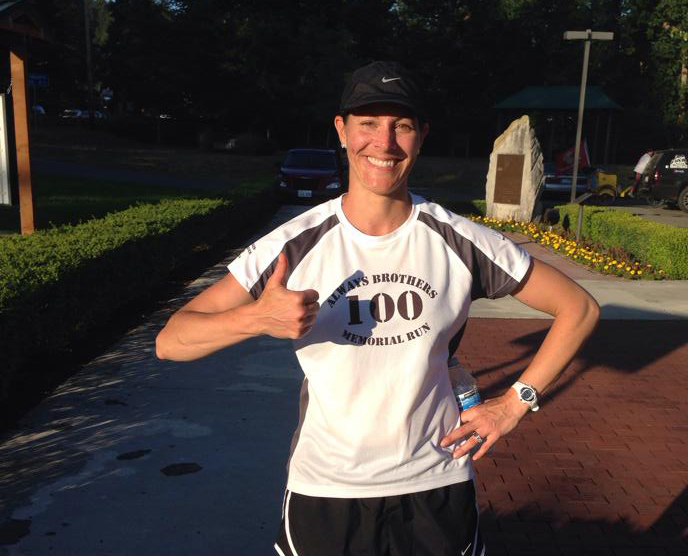If there’s one thing the Pacific Northwest is known for, it’s the blistering summer heat.
Wait a minute… that’s not right.
Typically our summers in Western Washington are “cool and comparatively dry,” as described by the Western Regional Climate Center of the Desert Research Institute of Nevada.
The normal high temperature for the Seattle area in July is 75.7 degrees Fahrenheit, according to the National Climatic Data Center. Needless to say, this recent string of 85+ degree days this month falls wells outside of the norm.
For those of us acclimated to the Pacific Northwest, a hot stretch can spell trouble when we’re exercising outdoors.
“It catches people by surprise,” said Celese Stevens, co-franchise owner and manager at Thrive Oak Harbor. “We’re not used to knowing what to do working out in the heat.. Whereas in North Carolina [where we previously lived], there was definitely front-of-mind awareness of the need to stay hydrated.”
So how can you stay cool when the temps start to scorch? Follow these tips:
1. Wear loose, cotton clothing
You may have worked your butt off to develop a statuesque physique, but form-fitting clothes are not the best option for beating the heat.
“Don’t wear tight-fitting or nylon clothing,” said Stevens. “Those are good for when it’s cool or you’re layering up. But in the summer while working out outdoors, the looser-fitting, the better.”
Cotton is a more “breathable” material, which means it allows for heat to escape. Synthetic materials have a greater propensity for retaining heat.
2. More salt, please!
While it’s obvious that you should drink lots of water (we’ll talk about that later), what you may not realize is how much salt you lose when you’re working out in the heat.
 Celese Stevens completes marathon distance of 26.2 miles in 85-degree summer heat!
Celese Stevens completes marathon distance of 26.2 miles in 85-degree summer heat!
“Sometimes people forget about the sodium,” said Stevens. “You want to stay hydrated, but you can’t drink so much water that you flush the sodium out. Your body needs that sodium to produce sweat and prevent you from cramping.”
If your sodium levels drop too far, you can suffer from hyponatremia which includes symptoms like nausea, vomiting, headache, confusion cramps and even seizures..
The best way to prevent this from happening is to consume some sodium-rich foods while exercising in the heat, according to a study in the Journal of Athletic Training.
Gels, chews, workout drinks and energy bars all contain sodium and are typically designed to not induce a gut bomb while you’re exercising. Talk to a staff member at your local Thrive Community Fitness center for specific recommendations.
3. Hydrate before it’s too late
Of course you should drink water while you’re exercising in the heat, but it’s equally important to hydrate before you start exercising.
Your body can lose more than a quart of water per hour during exercise, according to the American Council on Exercise (ACE).
The ACE recommends the following tips to stay hydrated:
- Drink 17-20 ounces of water two to three hours before the start of exercise.
- Drink 8 ounces of fluid 20 to 30 minutes prior to exercise or during warm-up.
- Drink 7-10 ounces of fluid every 10 to 20 minutes during exercise.
- Drink an additional 8 ounces of fluid within 30 minutes after exercising.
- Drink 16-24 ounces of fluid for every pound of body weight lost after exercise.
4. Be Shady
If you’re able to, make sure you wear a hat when you exercise outside.
Whether you’re donning a lightweight baseball cap or a giant straw sombrero, keeping direct sun off your face can help you stay cool.
Additionally, wearing sunglasses can help keep your eyes fresh and prevent long-term damage, said Stevens.
5. Take regular breaks
In the heat of the moment, it can be difficult to distinguish normal, exercise-induced fatigue from the first signs of heat stroke.
Stevens recommends regular breaks and self-assessments to ensure you’re staying cool.
“In the Marine Corp, they have a baby pool set up with ice water to get cooled down ASAP,” said Stevens, who is a former Marine along with her husband and business partner Michael Stevens..
Turning yourself into a human daiquiri is probably overkill for most of us, however.
When you do take breaks, be sure to sip water slowly. Also, apply ice or a cool drink to your wrists and neck, where major blood traffic takes place close to the surface. This allows you to cool down a bit faster, said Stevens.
If you’re feeling dizzy, noxious or have cool, clammy hands, those may be signs of heat stroke. Stay in the shade and rehydrate until you feel better.
For more tips on staying cool in the summertime, talk to an expert at your local Thrive Community Fitness center today!